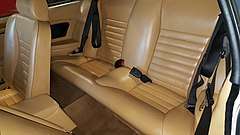2+2 (car body style)
The 2+2 is a version of the coupé car-body style that has two small rear seats for children or occasional usage, along with two front seats for the driver and front passenger.[1] Manufacturers which sell coupés both with and without rear seats often market the versions that include rear seats as "2+2"[2] or as 2-plus-2.

Definition

By definition, all cars in the 2+2 category have two front seats and two rear seats. Other common characteristics for 2+2 cars include relatively little room for the rear passengers and a coupé body with two doors.
Although many convertible, targa top and hatchback cars meet the literal definition of a 2+2, they are rarely considered 2+2s.
Usage
There are many coupé which meet the definition of a 2+2, but have not been described by the manufacturer as such. This is because the term 2+2 is most often used to distinguish cars from a 2-seat open version of the same model. Prominent examples are the classic Jaguar E-type fixed-head coupé 2+2, the Lotus Elan 2+2, the Nissan 300ZX 2+2, the Chevrolet Monza 2+2, the 1965–1966 Mustang 2+2[3] and the Pontiac 2+2 models.
The 1965 and 1966 Mustang Fastback was marketed as the "Mustang 2+2", because a fold-down rear seat was included as standard equipment. Where the standard (two-seat) Mustang had a "MUSTANG" emblem, the 2+2 model had a "MUSTANG 2+2" emblem. In 1967, the rear seat became optional, and the "2+2" designation was dropped.
Cars marketed as 2+2
References
- "Sedan vs. Coupe Cars: Meaning, Definition & Differences". www.automoblog.net. Retrieved 18 March 2018.
- "ZX History". www.project300tt.com. Retrieved 18 March 2018.
- "1964 Ford Mustang 2+2". www.themustangsource.com. Retrieved 23 March 2018.